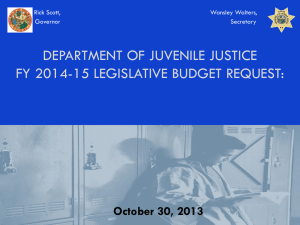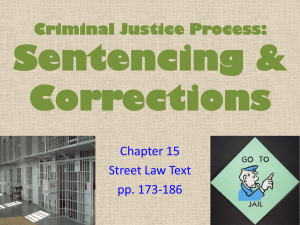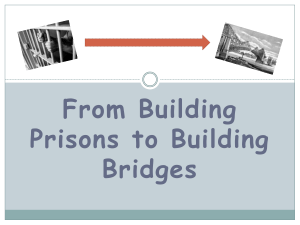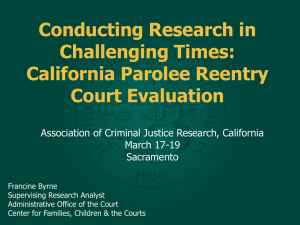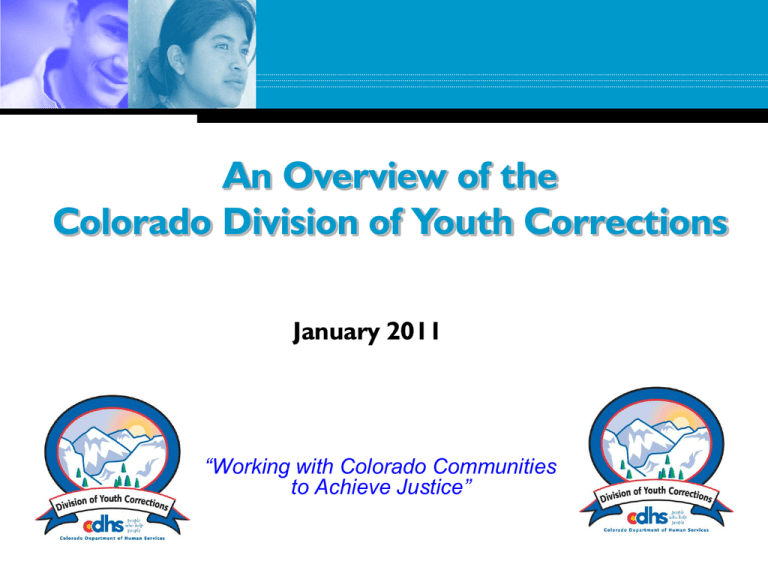
An Overview of the
Colorado Division of Youth Corrections
January 2011
“Working with Colorado Communities
to Achieve Justice”
DYC Vision
“Working with Colorado
Communities to Achieve Justice”
2
DYC Mission
To protect, restore, and improve public
safety through a continuum of services and
programs that:
• effectively supervise juvenile offenders;
• promote offender accountability to
victims and communities; and,
• build skills and competencies of youth to
become responsible citizens.
3
The Five Key Strategies
4
Colorado State Government
Legislative
Executive
Judicial
General
Assembly
State
Departments
District
Courts
Legislative
Staff
State
Agencies
Probation
5
Executive Branch
Governor
Corrections
Youth Offender System
Child Welfare
Human Services
Children, Youth and
Family Services
Youth Corrections
Public Safety
JJ Council
Child Care
SB 94
Detention
Commitment
Parole
6
DYC Service Continuums
Detention Continuum
•
Senate Bill 94 (Community Detention)
•
Secure and Staff Secure Detention
Commitment Continuum
•
Assessment
•
Residential Treatment Services
•
Parole Supervision
7
Detention Continuum
DYC Detention Operations
State operated
since 1973
DYC Regions
formed around
location of
detention centers
8
Detention Services
Supervision & Care
• Juveniles awaiting
Court hearings
• Juveniles awaiting
disposition
• Juveniles who receive
short-term sentences
• Juvenile & Municipal
Court Orders
9
Senate Bill 91-94
Community-Based
Detention Services
Allocation of Funds
Planning Committees
Collaboration
Ongoing Evaluation
Advisory Board
10
Commitment Services
Transfer of Legal
Custody
Result of
Adjudicatory
Hearing
Supervision, Care
and Treatment
11
Criteria For Commitment
19-2-212(a) C.R.S. Specifies that a “Working Group”
will establish criteria for both detention and
commitment of juveniles
Criteria is reviewed annually by the Statewide SB 94
Advisory Board
Criteria for commitment include type of offense, prior
history, and reasons why community placement
would not be appropriate.
12
Commitment Jurisdiction
Ages 10-20, for acts committed prior to a
youth’s 18th birthday (19-2-909, C.R.S.)
Ages 10-12, for Class 1, 2 or 3 felonies only
Majority of sentences are for a determinate
period of up to two years
Those over 18 at sentencing may receive jail or
community corrections (19-2-910, C.R.S.)
All DYC commitments discharged at maximum
age of 21
13
Commitment Flow Chart
Typical Case
Client Management
Commitment
Assessment
Residential
Care
Parole
Discharge
Community
Residential
1 month
14 mos.
3 mos.
6 mos.
Residential LOS = 18+ months
14
DYC Continuing Care Phases
Institution
Transition
Community
School Performance
Use of Free Time
Employment
Relationships
Family Issues
Substance Abuse
Mental Health
Attitudes
Aggression
Social Skills
Problems/Need Areas
15
Assessment Services
Risk Assessment & Classification
Colorado Juvenile Risk Assessment
Risk and Offense Severity determines residential
security and supervision expectations
Comprehensive Evaluation:
Educational/Vocational Assessment and Identification
of Individualized Needs
Holistic Medical Appraisal
Mental Health Screening and Assessment
Alcohol and Drug Screening and Assessment
Offense Specific Evaluation
Neuropsychological Screening and Assessment
16
Significant DYC Initiatives
Colorado Juvenile Risk Assessment
Motivational Interviewing
Multi-Disciplinary Teams
17
Division of Youth Corrections
Regional
Management
Structure
18
Commitment Placements
Residential Facility Types*:
1) State owned and operated
2) State owned, privately operated
3) Privately owned and operated
Residential Child Care Facilities (RCCF)
Therapeutic Residential Child Care Facilities (TRCCF)
Psychiatric Residential Treatment Facilities (PRTF)
Child Placement Agency (CPA)
*slides following are color-coded as indicated above
19
Commitment Services
• High Degree of Accountability and Structure
• Cognitive Behavioral Restructuring Approach
• Offense Specific Treatment
• Individual and Group Counseling
• Substance Abuse Intervention and Treatment
• Gender Specific Programming
• Life Skills and Transition Services
• Victim Awareness and Empathy
• Multi-family Group Services
20
Educational Services
• Youth are enrolled in year round educational programs, either
on or off ground
• Educational services range from 6th grade level through postsecondary
• Curriculum delivered that aligns with Colorado State Standards
• Differentiated instruction delivered to meet individual student
needs
• Career and Technical Education and work experience
opportunities provided
• Approximately 25% of population is post-secondary
• Approximately 50% of secondary population is diagnosed with
special needs
21
Overarching Client
Management
Client Management
Residential
Commitment
Parole
Transition
Discharge
Commitment Continuum
22
DYC Client Managers
Responsible for case management of committed
youth – from point of commitment through
discharge from parole
Develop individualized case plans, including
placement, treatment plan, and services
Serve as liaison to Courts, programs, families,
other agencies regarding client issues
Serve as Parole Officers during the period of
parole
23
Community Review Boards
19-2-210, C.R.S. – Counties may create a
Juvenile Community Review Board to approve
DYC community-level placements
Statute specifies information required and time
frames
19-1-103 (69), C.R.S. – Definition, also defining
membership
24
Required Community Review
Board Membership
School
Districts
Social/Human
Services
Bar
Association
Division of
Youth
Corrections
Private
Citizens
Probation
Law
Enforcement
25
Community Review Boards
Pursuant to Section 19-2-210, C.R.S. – A Community
Review Board shall review:
Information about the client and proposed placement,
including:
•
•
•
•
•
•
Delinquency History
Social History
Educational History
Mental Health Treatment History
Drug/Alcohol Treatment History
Summary of Institutional Progress.
26
Juvenile Parole
Juvenile Parole
Board
Supervision and
Services
Mandatory Parole
27
Juvenile Parole Board
Section 19-2-206, C.R.S.
Authority to grant, deny, defer, suspend, revoke, or
modify conditions of parole
Nine members, appointed by Governor
Human Services
Education
Public Safety
Labor & Employment
Local Elected Official
Four members – public at large
28
Juvenile Parole Services
• Individualized parole plans
• Parole plan is consistent with Discrete Case Plan
• Parole Officers provide direct supervision and liaison with
community resources and families
• Contract Parole Program Services
– Treatment Services; e.g., Multi-systemic Therapy; Functional
Family Therapy; Offense Specific; Drug/Alcohol
– Tracking and Mentoring
– Day Treatment and Day Reporting Programs
– Community-based services; e.g., housing, employment, school,
advocacy
29
Juvenile Parole
Mandatory parole enacted in 1996, Section
19-2-909(b), C.R.S.
Currently six months minimum for all youth
May be extended an additional 15 months
by Juvenile Parole Board
Parole Board may suspend or revoke parole
Jurisdiction ends at age 21
30
DYC Program Priorities &
Collaborative Partnerships
Senate Bill 94
Integrated Monitoring
Mental Health Treatment
Services
Integrated Data Systems
Drug / Alcohol Services
Boulder Managed Care
(IMPACT)
Medical Managed Care
Privatization
Education Services
Research
DYC Provider Council
HB 04-1451
33
Commitment Continuum of Care:
The Fundamentals
Actuarial Risk and Needs Assessment – Colorado
Juvenile Risk Assessment (CJRA)
Individualized Case Management – Target Resources
Enhanced Clinical Services in State Operated Facilities
Evidenced Based Practices in all Residential Programs
and all Non-Residential Services
Increased Emphasis on Transition and Re-integration
Use flexibility in Purchase of Contract Placements to
ensure resources follow youth vs. placing youth where
there are resources
Alignment to the Division’s Five Key Strategies
34
Continuum of Care Overview
35
Continuum of Care Services
• Mentoring
• Functional Family Therapy
• Multi-Systemic Therapy
• Aggression Replacement Training
• Restorative Justice Activities
• Outpatient Drug and Alcohol Services
• Job Skills Training
• Independent Living Support
36
Continuum Of Care Initiative:
Outcome Objectives
1) Reduce Growth in the Commitment Population
2) Reduce Pre- and Post-Discharge Recidivism
3) Reduce the Number of Juvenile Recommitments
4) Optimal Length of Time in Residential Placement
(least restrictive setting, with an emphasis on
community safety)
5) Reduce Criminogenic Risk Factors, as Measured by
the CJRA
37
Commitment ADP Trends
Residential Commitment
Average Daily Population
5 Year Trends
1500
1450
1400
1350
1250
1200
1150
28% decline in 4.5 Fiscal Years
1100
1050
1000
Jul
Aug
Sep
Oct
Nov
Dec
Jan
Feb
Mar
Apr
May
Jun
Jul
Aug
Sep
Oct
Nov
Dec
Jan
Feb
Mar
Apr
May
Jun
Jul
Aug
Sep
Oct
Nov
Dec
Jan
Feb
Mar
Apr
May
Jun
Jul
Aug
Sep
Oct
Nov
Dec
Jan
Feb
Mar
Apr
May
Jun
Jul
Aug
Sep
Oct
Nov
Dec
Jan
Feb
Mar
Apr
May
Jun
Jul
Aug
ADP
1300
FY 05-06
FY 06-07
FY 07-08
FY 08-09
FY 09-10
38
Changes in Risk to Re-Offend
Changes in CJRA Risk Levels – Risk Factors
Assessment to Discharge and Change
Percent in High Range Percentage in the High
Range at Discharge
Risk Factors by Domain of Scores at Assessment
School
41%
26%
Relationships
70%
56%
Family
32%
24%
Alcohol and Drugs
32%
17%
Mental Health
25%
22%
Attitudes / Behaviors
30%
22%
Aggression
27%
16%
Skills
36%
16%
% Change
-37%
-19%
-25%
-47%
-12%
-25%
-41%
-57%
**Table is based on Continuum of Care youth served in FY 2008-09.
39
Rate of Recommitment
Recommitment Rate
30%
25.0%
25%
20.9%
22.1%
22.3%
21.2%
FY 07
Continuum
Discharges
FY 08
Continuum
Discharges
FY 09
Discharge
Cohort
FY 10
Discharge
Cohort
Rate
20%
15%
10%
5%
0%
FY 05
Discharge
Cohort
40
Pre-Discharge Recidivism
Pre-Discharge Recidivism
40%
39.1%
38.5%
37.2%
35.8%
33.5%
35%
Rate
34.6%
30%
25%
20%
FY05
Discharge
Cohort
FY06
Discharge
Cohort
FY07
Discharge
Cohort
FY 08
Discharge
Cohort
FY 09
Discharge
Cohort
FY 10
Discharge
Cohort*
Discharge Group
*2009-10 is the estimated recidivism rate based on early reporting of filings; rates are likely to41
increase once finalized.
Juvenile Justice Filtering Process
to Commitment
FY 2009-10
Total Population (ages 10-17)
539,167
Juvenile Arrests
39,876
Juvenile Delinquency Filings
11,640
Detention
Admissions
9,102
743
100%
7.4%
2.2%
1.7%
New Commitments
0.1%
42
700
760
750
2009-10
766
2008-09
2007-08
843 824
2006-07
2005-06
2004-05
950
2003-04
2002-03
848
2001-02
800
2000-01
850
1999-00
900
1998-99
Number of Youth
New Commitments
1000
924 950 933
878
827
795
743
43
LOS (months)
20
19
18
17
16
15
14
13
12
11
10
FY 2009-10
FY 2008-09
FY 2007-08
FY 2006-07
FY 2005-06
FY 2004-05
FY 2003-04
FY 2002-03
FY 2001-02
FY 2000-01
FY 1999-00
FY 1998-99
FY 1997-98
FY 1996-97
FY 1995-96
FY 1994-95
FY 1993-94
FY 1992-93
FY 1991-92
FY 1990-91
FY 1989-90
FY 1988-89
FY 1987-88
Commitment LOS Trends
44
Commitment Population
FY 2009-10
New Commitments
743
Number of Clients Served
2,404
Average Length of Stay
18.9 Months
Average Daily Population
1,171.6
State Secure Committed ADP
502.4
Staff Supervised / Contract ADP
487.1
Community / Other Residential ADP
182.1
45
Ethnicity Distribution*
FY 09-10 Commitment ADP
3%
34%
43%
20%
Anglo-American
African American
*Rounded to the nearest decimal
N=1171.6 ADP
Hispanic / Latino
Other
46
Most Severe Offense Type*
FY 09-10 Commitment ADP
6%
5% 2%
46%
41%
Person
Property
Drug
Weapon
Other
*Rounded to the nearest decimal
N=1171.6 ADP
Missing, N=2.0 ADP
47
Sex Offender Trends*
ADP of Committed Youth
FY 09-10 Commitment ADP
270
250
230
210
190
170
150
130
Committed Sex Offenders
FY
9900
FY
0001
FY
0102
FY
0203
FY
0304
FY
0405
FY
0506
FY
0607
FY
0708
FY
0809
FY
0910
160
199
205
220
246
250
223
234
212
180
151
* Includes all Sex Offenders as defined by the SOMB Standards.
48
Substance Abuse Level*
FY 09-10 Commitment ADP
14%
22%
64%
Prevention
Intervention
Treatment
*Rounded to the nearest decimal
N=1171.6 ADP
49
ADP of Committed Youth
Substance Abuse Trends*
1250
1200
1150
1100
1050
1000
950
900
FY 98- FY 99- FY 00- FY 01- FY 02- FY 03- FY 04- FY 05- FY 06- FY 07- FY 08- FY 0999
00
01
02
03
04
05
06
07
08
09
10
Intervention and TX Level
962
1010 1044
1055 1102 1125 1199 1220 1191
* Based on the Clinical Assessment (Utilizing SUS-1a and ASAP)
1085 1058 1002
50
Mental Health Needs*
FY 09-10 Commitment ADP
35%
53%
12%
None/Low-Moderate
*Rounded to the nearest decimal
N=1171.6 ADP
High-Moderate
Severe
51
ADP of Committed Youth
Mental Health Trends*
1000
900
800
700
600
500
400
300
200
100
0
High Moderate To Severe
Severe
FY
9899
FY
9900
FY
0001
FY
0102
FY
0203
FY
0304
FY
0405
FY
0506
FY
0607
FY
0708
FY
0809
FY
0910
227
283
420
469
472
549
738
862
647
421
313
264
43
58
78
98
106
97
147
176
138
104
80
60
* Based on the CCAR Scores Administered at Assessment
52
Gender Distribution*
FY 09-10 Commitment ADP
13%
157.4
1071.8
Male
*Rounded to the nearest decimal
N=1171.6 ADP
87%
Female
53
ADP of Committed Youth
Female Offender Trends*
190
180
170
160
150
140
FY 98-99 to 09-10
130
31% Growth
120
110
100
Female Offenders
FY
9899
FY
9900
FY
0001
FY
0102
FY
0203
FY
0304
FY
0405
FY
0506
FY
0607
FY
0708
FY
0809
FY
0910
120
140
130
137
149
160
183
185
158
152
157
157
*Estimated data for FY 2001-02 and FY 2002-03
54
10-Year Population Growth
FY 2000-01 to FY 2009-10
Average Daily Population
1140
Decline
of
- 9.6 %
1120
1100
1080
180
160
21%
Growth
1060
140
1040
1020
120
1000
980
100
960
Male
FY 2000-01
Female
FY 2009-10
55
Parole Population
FY 2009-10
Number of Clients
Served 1,270
Average Length of
Stay 6.7 Months
Average Daily
Population 446.9
56
Lucia Waterman
Central Region Assistant Director
4120 S. Julian Way
Denver, CO 80236
303-866-7724 office
Lucia.waterman@state.co.us
Jorge Aleman
Parole & Transition Services Coordinator
4120 S. Julian Way
Denver, CO 80236
303-945-9782
Jorge.aleman@state.co.us
57

